Motorola new Moto G LTE review
Boring and solid competition to

In 2013 Motorola tried to regain a foothold in the European smartphone market and came up with the Moto G. It was later given a brother with 4G support and now the second generation is available.
The first Moto G stood out because of its combination of good specifications and friendly price tag. That line wants to continue the new Moto G LTE and has a 5 inch screen with HD resolution, a Qualcomm Snapdragon 400 processor with four cores at 1.2 GHz, 8 megapixel camera, 1 GB of working memory and a memory card slot. There are also stereo speakers on the front.
Depending on your specific requirements, you have a fairly wide choice of smartphones for around 200 euros. Within the Android segment, for example, the LG Spirit 4G is an interesting option, but also the Honor 4X and HTC Desire 620 will do the consumer favor. For a device running on Windows, the Microsoft Lumia 640 LTE is worth considering.
What's with the device?
Like the other phones we're testing, the new Moto G LTE comes in a nice compact box. But actually, it might as well have been sent in a sturdy envelope, because apart from the phone, the box contains only a white microUSB cable, quick start guide and safety instructions booklet. A closer inspection of the text on the box will indeed reveal that the plug for the socket is available separately. Although almost everyone nowadays has one or more phone chargers and headphones in the house, Motorola is not making the best of it as far as we are concerned.
Appearance
Identifying the right Motorola appliance is no easy task for the untrained eye. Apart from the small difference in naming, the external differences are not very big either. This Moto G (2015) looks a lot like the first generation Moto E but at the back it also looks a lot like the first Moto X and of course its own predecessor. What's more, the new Moto E has the same screen size as the old Moto G. Are you still there?


".
The appearance of the new Moto G LTE is on the boring side, but that doesn't detract from the effectiveness of the design. All sides of the unit are slightly slanted, so the back is a fraction larger than the front. The sides are half covered by a shiny plastic edge and half by the back cover. Around the device are the buttons on the right, at the bottom of the microUSB connector and on top of the headset connector. The new Moto G with 4G support is only available with a black front. Our test device had a matte black backcover with a rubbery layer on top that was quite sensitive to stains.


".
The front of the unit is completely made of glass with the exception of two metal ridges in the slots for the speakers. These slots are substantial dust receptacles, and there is also a gap between the glass and the edge of the unit that contains crumbs and dust. Between the top speaker and the selfie camera is a white notification light.

The back has an ergonomic bulge and the camera lens is slightly recessed in it. The backcover can be removed from the microUSB connection with appropriate force. This is necessary to insert the SIM and possibly a microSD card. The battery cannot be changed. Because of its thickness, the new Moto G LTE looks a bit clumsy, but after some getting used to it, it is comfortable to handle. Only the slightly sharp edge at the bottom is not always nice when resting on your little finger. It would have been nice if this edge was nicely rounded just like the top.
Endurance
The new Moto G LTE has a slightly larger battery than its brother without 4G support, namely 2,390 mAh compared to 2,070 mAh. Well, 4G can use a bit more energy but this extra content is especially good for endurance. Up to 36 hours on one battery charge we came almost effortlessly. Whether you can make two days full depends on your usage pattern. We had set up two email accounts and on an average day we mainly use WhatsApp, social media, news apps and make the occasional phone call.


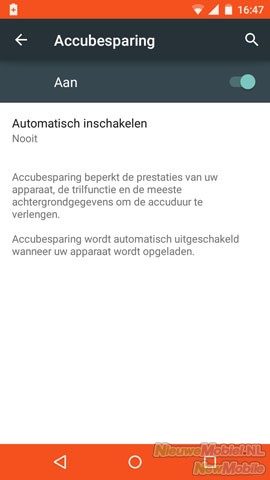
".
With the arrival of Lollipop, Android also got a battery saving function. You can turn it on manually or automatically at 15 or 5 percent remaining battery percentage. This limits the performance of the device, the vibration function and most background data and can be found by pressing the three dots at the top right of the screen in the battery overview. Once the device is connected to the charger, it indicates how long it will take before it is full.
Call quality
The phone application in Android 5.0 has been changed again and further improved. At the top there is a search bar to search by name or phone number. Strangely enough, this does not allow you to search for nearby companies on the new Moto G LTE, as you can on a Nexus. By the way, a contact can also be found using smartdial on the numeric keyboard via the round button at the bottom of the screen. Below the search bar you will find the last called contact and then three titles from different tabs. The default tab is the shortcut with favourites and most frequently used contacts.


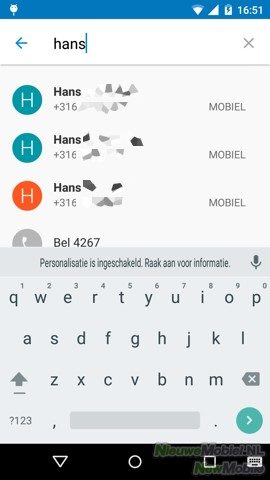
".
The interface is clear and therefore quick to use. Incoming calls can be rejected by one of four previously set SMS messages. The ear loudspeaker can be loud enough but in some cases sounds a bit hollow or shrill. Especially the former is also the case for the stereo speakers.
Display
Compared to the first generation Moto G, the screen diagonal has grown from 4.5 to 5 inches. However, the resolution has remained the same at 1,280 x 720 pixels. This means that the processor, which has remained the same in terms of power, no longer needs to control pixels. Moreover, the technology has changed from AMOLED to TFT. It is not very disturbing that the pixel density has decreased. Only some icons of apps are less sharp. Despite the fact that there is no AMOLED, colors are rendered nice and warm. The range of screen brightness is especially large for the lower intensity. During the day this is of little use, but in the evening it's nice to check Facebook in bed for the last time. In bright sunlight, the readability is also good.


Motorola has a so-called 'reactive screen' mode built into Android. This causes the screen to briefly light up when a new notification arrives to show it in black and white on a black background.
Menu
Motorola is one of the few manufacturers to choose to leave the Android interface on all its devices largely untouched. This ensures that updates can be rolled out quickly. The new Moto G LTE runs on Android 5.0.2. In the meantime, 5.1 has also been released, but this means that the device is already included in the 10% of all Android phones worldwide that have Android 5.0 Lollipop.

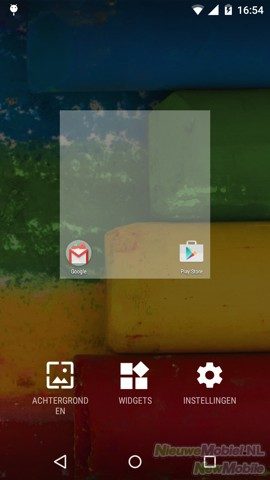

Material Design was introduced with Android 5.0. This is Google's new design style and it prescribes what animations, colors, fonts and app components should look like. The emphasis was placed on a 'flatter' interface and more logical animations that should make Android more of a whole by making apps more compatible with each other.


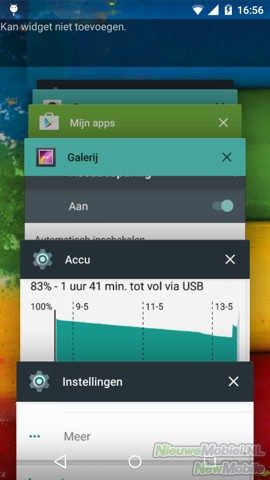
".
There are still up to five start screens available but now not the middle one but most left one is the start screen. Another turn to the left again next to that we find Google Now with lots of updates on separate maps that may be of interest to you. The application menu has been given a white background and icons are shown in a grid of four by five.



".
The screen with shortcuts to settings such as WiFi and Bluetooth, as well as a flashlight, is no longer behind the notification window but above it. This means that notifications still appear by dragging the status bar down but to get to the settings you have to repeat this movement again. Notifications are now also shown on the lock screen. You can wipe them away or open the corresponding app directly by tapping it twice.
The new Moto G LTE doesn't open applications at lightning speed, but everything generally goes smoothly and the interface runs smoothly. Only the multitasking window usually takes some time to open.
Phonebook
Although there is a tab for contacts in the phone application, there is also a separate contact application. This of course contains your Google contacts, but SIM contacts, other email accounts and apps such as Twitter or Linkedin can also be brought in. In standard Android it is not possible to synchronize your phonebook with Facebook. You will have to download a separate app for this. The contact application also has a tab for your favorites. In the settings you can change the visible contacts, accounts and the layout of the list.
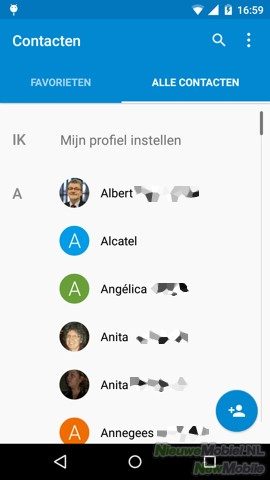

".
Messaging
For SMS and MMS you can use messages or Hangouts. You can indicate your preference in the settings menu. Meanwhile Google has also developed a new Messenger application that is more compatible with Android 5.0 than the rather outdated messaging app, but it still needs to be downloaded manually from the Play Store.



".
Although there is a separate icon in the menu for an email application other than Gmail, it immediately indicates that you can now use other accounts in Gmail than Google. Different accounts can therefore also be displayed in a combined mailbox. If you want to display messages grouped together in the same mailbox you have to enable this in the settings.



".
With the arrival of Android 5.0, the keyboard has also been renewed and, as far as we are concerned, it functions extremely well. Although it is useful to go through the settings in the beginning. For example, to set a second input language. A number of options can also be adjusted for input by dragging and dropping from letter to letter. The layout of the keyboard can't be changed much, but actually everything is in the right place.
Connectivity
Besides the added support for 4G, the new Moto G LTE can of course also connect via WiFi and Bluetooth. Everything works properly and if we mention the possibility of tethering, we've had all the connection options.



Chrome is part of Android and is the only internet browser on the new Moto G LTE. Chrome has a sleek interface that allows pages to be opened in multiple tabs and displayed in full screen. The browser can retrieve your bookmarks from Chrome on the PC via your Google account, but it can also synchronise your search history in another browser.
Camera
The camera was a weak spot in the first Moto G, so on the new Moto G LTE it has grown to an 8.0 megapixel version with autofocus. The camera is actually the only application where Motorola has chosen to replace the standard application with its own. This has particular consequences for the interface. For example, there is no separate button to take a picture.


When using the camera for the first time, a short wizard follows to explain how it works. This way you will find out how to take a picture, how to zoom and that from the left side a dial can be dragged into the picture for the settings. The setting possibilities are limited but the most necessary options are available. You can adjust HDR, flash, focus/exposure setup, video SloMo, panorama, timer, location, storage memory, resolution and shutter sound.


With the help of some sunlight, the new Moto G LTE takes very decent photos with beautiful colors and sufficient detail. When the sun is gone, details and contrast are still well taken care of but the image is a lot darker. Because you can hardly adjust the settings, there is not much you can do about it. The flash is not very bright but it does give an even exposure at the short distance in the middle with some vignetting at the outer edge. Besides the somewhat cumbersome Google Photos, Motorola fortunately also delivers another gallery app. This gives a much clearer view of the images.

Click above for more sample photos of the Motorola new Moto G LTE (2015)
.
Existing programs
The remaining apps installed on the new Moto G LTE are Calendar, Alert, Assist, Calculator, Documents, Downloads, FM Radio, Photos, Gallery, Google, Google Drive, Google+, Help, Clock, Maps, Migrate, Play books/films/games/kiosk/music, Translate and YouTube.



In addition to another camera and gallery, Motorola also adds alert, assist, help and migrate to the standard package. The first is an app for sharing your location with family and friends in case of an emergency. Assist can automatically adjust settings when you are sleeping, driving, in a meeting or at home. Help can speak for itself and migrate allows you to transfer photos, videos, SMS messages, call history and SIM contacts from your old phone to your new one.
Conclusion
The inside and outside of the new Moto G LTE has little fuss. The somewhat boring appearance with lots of plastic may not raise expectations too high, but the device doesn't really have any annoying shortcomings. With an improved battery, monitor, camera and stereo speakers on the front, the new Moto G LTE is clearly a step forward compared to the first generation. The endurance and monitor in particular are points on which it scores well.
Android as Google conceived and designed it now offers a beautiful and mature interface that doesn't really need any more fancy from phone manufacturers themselves. Motorola has understood this very well and they only add a few helpful apps. What's more, Android runs smoothly on the hardware of the new Moto G LTE without any additions.

